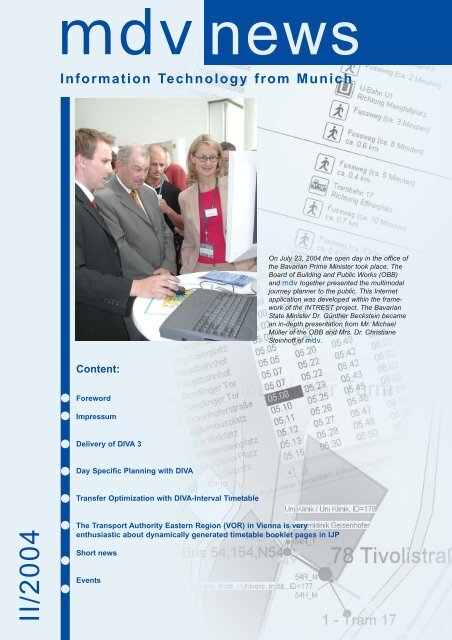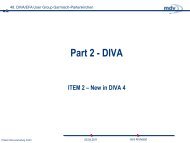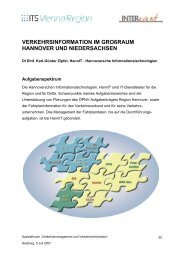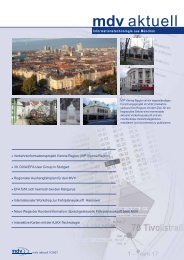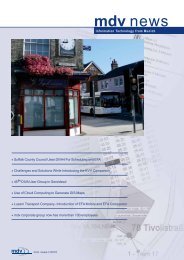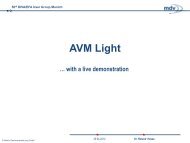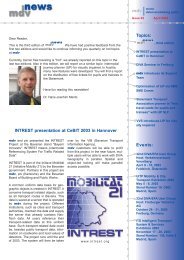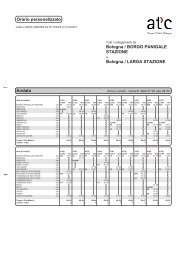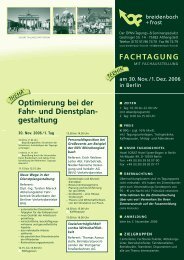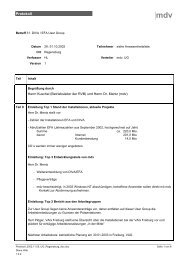II/2004 - Mentz Datenverarbeitung GmbH
II/2004 - Mentz Datenverarbeitung GmbH
II/2004 - Mentz Datenverarbeitung GmbH
Create successful ePaper yourself
Turn your PDF publications into a flip-book with our unique Google optimized e-Paper software.
<strong>II</strong>/<strong>2004</strong><br />
mdv<br />
Information Technology from Munich<br />
Content:<br />
Foreword<br />
Impressum<br />
Delivery of DIVA 3<br />
Day Specific Planning with DIVA<br />
Transfer Optimization with DIVA-Interval Timetable<br />
The Transport Authority Eastern Region (VOR) in Vienna is very<br />
enthusiastic about dynamically generated timetable booklet pages in IJP<br />
Short news<br />
Events<br />
news<br />
On July 23, <strong>2004</strong> the open day in the office of<br />
the Bavarian Prime Minister took place. The<br />
Board of Building and Public Works (OBB)<br />
and mdv together presented the multimodal<br />
journey planner to the public. This Internet<br />
application was developed within the framework<br />
of the INTREST project. The Bavarian<br />
State Minister Dr. Günther Beckstein became<br />
an in-depth presentation from Mr. Michael<br />
Müller of the OBB and Mrs. Dr. Christiane<br />
Steinhoff of mdv.
Foreword<br />
Masthead:<br />
Publisher:<br />
<strong>Mentz</strong> <strong>Datenverarbeitung</strong> <strong>GmbH</strong><br />
Grillparzerstraße 18<br />
D-81675 München<br />
Tel: ++49.89.418 68.0<br />
Fax: ++49.89.418 68.160<br />
Editorial:<br />
Marjolijn Horsselenberg<br />
Design:<br />
Rosemarie <strong>Mentz</strong><br />
Info:<br />
horsselenberg@m.mentzdv.de<br />
Masthead<br />
In autumn 2002, we started to<br />
regularly send you information<br />
via . The first six<br />
issues of received a<br />
great response. We will continue<br />
with mdv news ; however<br />
we would like increase our<br />
focus on more in-depth information.<br />
Therefore, we have<br />
slightly changed the existing<br />
layout. In the future, we will<br />
inform you more about developed<br />
products through professional<br />
articles. In this<br />
issue, there will be two such<br />
articles.<br />
Day specific planning within the Days of Operation module is a<br />
topic that is important for many customers. With the R <strong>2004</strong>/1,<br />
this was released, and in R <strong>2004</strong>/2 some additional features<br />
were added. The developments were implemented free of cost<br />
within the framework of the maintenance agreement. The<br />
related article provides an insight into this topic and its basic<br />
concepts.<br />
mdv news <strong>II</strong>/<strong>2004</strong> - 2 -<br />
Our branch offices:<br />
<strong>Mentz</strong> <strong>Datenverarbeitung</strong> <strong>GmbH</strong><br />
Westfalenstraße 224<br />
48165 Münster<br />
Tel.: ++49.2501.969.0<br />
Fax: ++49.2501.969.300<br />
E-mail: mdv@ms.mentzdv.de<br />
Transfer optimization has gained in importance. mdv has<br />
worked hard during the last year on a new module, the DIVA<br />
Interval Timetable. With the support of the Transport Authority<br />
of Zurich and the Transport Authority of Basel we have created<br />
a module that enables the transport planner to analyse the existing<br />
network and transfers and run a fully automatic optimization<br />
program. This topic is explained more in depth in the<br />
second article.<br />
Of course we also would like to continue to inform you about<br />
current implementations and experiences. Since the end of<br />
2003, the Transport Authority Eastern Region (VOR) based in<br />
Vienna uses the IJP for dynamic generation of timetable<br />
booklet pages on the Internet . They draw a very favourable<br />
balance.<br />
At the end you will find an overview of upcoming events. We<br />
hope that we can welcome you to a User Group, exhibition,<br />
symposium or demonstration in the near future.<br />
We hope that you enjoy reading this edition of mdv news !<br />
Dr. Hans-J. <strong>Mentz</strong><br />
<strong>Mentz</strong> <strong>Datenverarbeitung</strong> <strong>GmbH</strong><br />
Rotebühlstraße 121<br />
70178 Stuttgart<br />
Tel.: ++49:711.61 55 43.0<br />
Fax: ++49.711.61 55 43.30<br />
E-mail: mdv@s.mentzdv.de<br />
Internet:www.mentzdv.de<br />
<strong>Mentz</strong> Informatique SARL (mi)<br />
11, rue des Corroyeurs<br />
F-67200 Strasbourg<br />
Tél.: ++33.3.88 26 95 30<br />
Fax: ++33.3.88.30.23.18<br />
E-mail: info@mentz-informatique.fr
mdv news <strong>II</strong>/<strong>2004</strong> - 3 -<br />
By the end of the nineties, the DIVA<br />
system had developed into a standardized<br />
tool for transport authorities to collect<br />
and publish timetable data. Through<br />
the cooperation with HPW (now<br />
Siemens TTS) and the acquisition of the<br />
planning program IFES/DIES, the DIVA<br />
system was further developed to be<br />
used by of transport operators. The first<br />
implementation at an urban transport<br />
operator was in the end of 2000 at the<br />
Transport Operator of Freiburg.<br />
During the following years, the DIVA<br />
system was implemented successfully at<br />
many urban transport operators. The<br />
requirements to the system increased,<br />
especially through the use of the system<br />
by transport authorities that run integrated<br />
planning for various transport operators.<br />
As a result of this development, DIVA is<br />
today the only planning program that<br />
supports planning for both regional and<br />
urban transport operators, train and<br />
track related planning, planning of offered<br />
services, publishing, and the supply<br />
of necessary interfaces.<br />
mdv started the development of DIVA 3<br />
during the middle of 2000. In many discussions<br />
with the customers, for example<br />
at the user groups, the requirements<br />
for DIVA 3 were compiled. These are<br />
mainly:<br />
- The complete system should better<br />
support large installations with 20 or<br />
more parallel working users. This<br />
required the new development of the<br />
Common Data Server. The old version<br />
of the server was optimized for<br />
maximum work performance for up to<br />
three users. The new Common Data<br />
Server uses new techniques for network<br />
communication and efficient use<br />
of resources on the server hardware.<br />
The communication between the<br />
Common data Server and the clients<br />
was completely developed on a<br />
CORBA basis. CORBA is a technique<br />
that enables the transfer of whole<br />
objects (for example, a Stop with all<br />
sub-structures, such as areas, platforms<br />
and attributes) via the network.<br />
CORBA works parallel and therefore<br />
uses modern hardware optimally.<br />
Current servers normally have several<br />
processors. Multiple processors<br />
are also well supported by operating<br />
systems since Windows 2000. The<br />
Common Data Server is therefore a<br />
process with many program threads,<br />
which can be executed in parallel.<br />
Thus, if several users request data<br />
from the server at the same time,<br />
these requests can be executed in<br />
parallel. This greatly increases the<br />
performance of the complete system.<br />
- Installations with many users requested<br />
an access rights policy in order<br />
to regulate access to the data. DIVA<br />
Access Rights is a part of all DIVA<br />
programs. It is not necessary to use<br />
DIVA Access Rights. It can be deactivated<br />
for users that do not need it.<br />
- The design possibilities in the presentation<br />
programs, especially the Stop<br />
Timetable, should be more flexible.<br />
The presentation programs should<br />
also be able to compute print outputs<br />
for the Intermodal Journey Planner.<br />
Therefore the Stop Timetable, Book<br />
Typesetting, and CBS (Central Bus<br />
Stop) modules were changed into a<br />
client/server system. At the server<br />
side, the presentation server was<br />
implemented bundle the requests and<br />
run the computation. Thus, several<br />
presentation programs are also available<br />
in the Internet.<br />
- With DIVA 3, the new days of operation<br />
concept was implemented for<br />
operational planning. Details about<br />
this can be found in the article<br />
"Day Specific<br />
Planning in<br />
DIVA" this<br />
issue of mdv news .<br />
The development and<br />
delivery of DIVA 3 was<br />
to be very smooth. The changes<br />
were also supposed to be available<br />
as soon as possible. The<br />
changes were made during the<br />
last three years, without problems<br />
for the customers.<br />
Delivery of DIVA3<br />
With the DIVA Release R2/<strong>2004</strong> the<br />
developments of DIVA 3 are completed.<br />
DIVA has noticeably grown, which is<br />
shown through the number of customers.<br />
We support, for example, installations<br />
with more than 3,500 routes and<br />
15,000 stops in one network. Today,<br />
DIVA is the only planning program which<br />
enables integrated planning (timetable/<br />
vehicle scheduling, duty scheduling,<br />
GIS, optimization, planning of offered<br />
services, personnel deployment, publication,<br />
IJP, etc.), including the supply of<br />
an AVL system, for all transport operators<br />
in a large transport authority.<br />
What happens next? The development<br />
of DIVA 4 has already started. We have<br />
collected requirements during the last<br />
User Group at the NVBW in Stuttgart<br />
and discussed them with the users. We<br />
will take the requirements and prepare a<br />
concept for the implementation of DIVA 4<br />
within the next months. We are all looking<br />
forward to the exciting further developments<br />
of the system.<br />
Your contact person:<br />
Wilfried Düx<br />
duex@m.mentzdv.de<br />
Tel.: ++49 89 418 68 114
Day Specific Planning with DIVA<br />
Day specific planning is used very differently<br />
by the individual transport operators.<br />
Some DIVA users cannot offer services<br />
according to the scheduled timetable<br />
on 80% of all operating days due to<br />
road works, exhibitions, etc. Naturally,<br />
these changes in the timetable must be<br />
planned and communicated to the passenger.<br />
Actually, day specific planning is nothing<br />
special. Through the definition of a service<br />
calendar, each calendar day is allocated<br />
to a day type. However, this can<br />
get very complicated for the user.<br />
Additionally, a large portion of the data<br />
must be redundantly entered and saved.<br />
The amount of data to be entered<br />
increases greatly with an increase in the<br />
number of routes. If, for example, on<br />
one day a route serves another route<br />
option due to road works, a new day<br />
type must be created for this calendar<br />
day. The planning during road works is<br />
carried out in the new day type. The problem<br />
with this: many other lines must be<br />
copied into the new day type. You can<br />
imagine what happens if two lines have<br />
separate road works deviations that<br />
timely overlap.<br />
The planning of a route group<br />
should be possible without influencing<br />
other route groups. In a<br />
route group, all routes that<br />
change are pooled. Within a<br />
route group, all blocks are consistent.<br />
For the first time, this is solved in<br />
DIVA through the introduction of a<br />
calendar per route group. In this<br />
calendar only special occasions<br />
concerning the route group are<br />
defined. The calendar of one<br />
route group does not influence<br />
the calendar of the other route<br />
group.<br />
This solution sounds trivial but<br />
has serious consequences for<br />
the DIVA program and its users.<br />
How are calendars per route<br />
group to be exported to VDV<br />
compatible systems such as AVL<br />
systems and passenger counting<br />
systems? Especially these interfaces<br />
are an important part of the<br />
DIVA system and were, amongst<br />
others, responsible for the success<br />
of DIVA in the last years.<br />
This is possible through the introduction<br />
of a network-wide valid<br />
service calendar that can be<br />
mdv news <strong>II</strong>/<strong>2004</strong> - 4 -<br />
used, for example, for the VDV export.<br />
The calendars that are defined for each<br />
individual route group must be mapped<br />
on this network-wide service calendar.<br />
And how should the duty schedule<br />
work? The duty schedule does not know<br />
any route groups. The calendar of the<br />
duty schedule must work for several<br />
route groups. Often a reduced or extended<br />
calendar is necessary for duty scheduling,<br />
for example because services<br />
are not planned in the timetable schedule<br />
but are only defined as secondary<br />
service in the duty schedule. Therefore,<br />
in DIVA the calendar of the duty schedule<br />
can be extended and modified, based<br />
on the service calendar of the timetable<br />
schedule.<br />
For the publication of timetable data for<br />
the passenger, day type specific data is<br />
mostly not of interest. If all details of day<br />
specific planning would be presented,<br />
for example in a stop timetable, the passenger<br />
would drown in footnotes. In order<br />
to keep the stop timetable readable, the<br />
data are normally smoothed out. Therefore,<br />
in DIVA it is also possible to define<br />
a special calendar for publication purposes.<br />
Day specific planning can basically be<br />
performed following three different strategies:<br />
1. The service calendar is identical with<br />
the calendars of the route groups.<br />
This is a wise strategy for smaller<br />
operators with few routes.<br />
2. A calendar is defined per route group.<br />
The service calendar is defined in<br />
such way that on the one hand all<br />
route groups can be scheduled exactly<br />
and on the other hand as few day<br />
types as possible are created in the<br />
service calendar. This strategy is useful<br />
if a restriction on the number of<br />
day types in the consuming systems<br />
(AVL, passenger counting, etc) exists<br />
which excludes the third strategy.<br />
This is the case for most operators.<br />
3. Parallel to the second strategy, a<br />
calendar per route group is defined.<br />
The network-wide valid service calendar<br />
is defined on a 365 day types per<br />
year basis. This is a sensible strategy<br />
when more than one operator is planned<br />
in a timetable schedule. This<br />
strategy implies that the consuming<br />
DIVA Graphic Schedule enables the handling of overall day types in the new days of operation concept. The program sh
systems can deal with the larger<br />
quantity of data and range of values.<br />
Such a large extension in the planning<br />
software must of course be carefully<br />
implemented at each user. In April <strong>2004</strong>,<br />
a workshop in Karlsruhe was organised<br />
in order to discuss the new functionalities.<br />
More than 65 users attended this<br />
workshop.<br />
After the workshop in Karlsruhe, the implementation<br />
of the new DIVA release,<br />
the optimal utilization of all new possibilities,<br />
and the decision for one of the<br />
above strategies were worked out with<br />
the users within a customer specific<br />
training.<br />
The new DIVA release was delivered to<br />
the DIVA users without additional<br />
licence costs. The development was<br />
financed completely through maintenance<br />
resources.<br />
From the implementation experiences<br />
and the feedback from the users, more<br />
requirements for day specific planning<br />
arose for several components of the<br />
DIVA system. Most of these require-<br />
ments have been implemented in<br />
the August release (R2/<strong>2004</strong>).<br />
The implementation of day specific<br />
planning was created in close<br />
collaboration with the users. The<br />
users were greatly involved in<br />
the development process in the<br />
form of workshops. Only in this<br />
way, it has been possible to take<br />
the requirements optimally into<br />
account. We would like use this<br />
opportunity to thank our customers<br />
for their collaboration.<br />
Through the new days of operation<br />
concept, the DIVA system<br />
has taken a large step forward.<br />
The reactions of the users show<br />
us that the developments optimally<br />
meet the requirements of<br />
the users.<br />
With the new days of operation concept,<br />
the DIVA system now has an additional<br />
distinguishing feature. No other planning<br />
program offers for day specific planning<br />
such a consequent optimal support in all<br />
components (timetable planning, duty<br />
scheduling, personnel deployment,<br />
ows whether a trip is also included in another day type and enables the use of handling features for all day types.<br />
mdv news <strong>II</strong>/<strong>2004</strong> - 5 -<br />
Day Specific Planning with DIVA<br />
Mr. Barth, responsible transport planner for the VAG in<br />
Freiburg: "End of 2000, we implemented DIVA within<br />
the framework of the acquisition of an AVL system. We<br />
were at that time already very enthusiastic about the<br />
possibilities of the system. The implementation of the<br />
new days of operation concept enables us to realize day<br />
specific planning even more accurately. The complete<br />
planning process has noticeably accelerated. This is in<br />
the end very positive for our passengers."<br />
presentation, journey planner, and interfaces<br />
for RBL systems).<br />
Your contact person:<br />
Dr. Markus Alefeld<br />
alefeld@m.mentzdv.de<br />
Tel. ++49 89 41868 119
Transfer Optimization with<br />
DIVA-Interval Timetable<br />
Every operator is interested in optimizing<br />
its processes. Generally, operators<br />
want to optimize those internal processes<br />
which decrease costs. However, it<br />
is very difficult to balance these optimizations<br />
with optimizations on the customer's<br />
side. But what would you say if<br />
you were handed a tool that makes your<br />
offered public transport services more<br />
attractive to your customers, increases<br />
your operator income, and at the same<br />
time decreases your operator cost? In<br />
case you are interested in this, DIVA-<br />
Interval Timetable could be the right tool<br />
for you...<br />
Transfer Optimization - what is it?<br />
All transport planners are familiar with<br />
the following problem: the passenger<br />
wants the public transport to have short<br />
time intervals, routes which follow the<br />
same path to be time-wise evenly distributed,<br />
and interchange transfers with<br />
minimal waiting times. In particular, the<br />
realisation of minimal waiting times for<br />
as many transfers as possible is a typical<br />
optimization problem. On the other<br />
hand, in order to reduce costs, the transport<br />
operator wants to manage blocks<br />
with the least amount of vehicles possible,<br />
while keeping with the operator's<br />
legal and technical requirements. This<br />
also influences the transfer situation<br />
along the route. It is not possible to<br />
satisfy both sides, passenger and operator,<br />
completely. So, at what point are<br />
the requirements of both sides optimally<br />
met?<br />
The experienced transport planner<br />
resolves this problem intuitively and<br />
realizes practical results. Because<br />
small changes in the interval-based<br />
timetable can often have a large impact,<br />
the transport planner bases the new<br />
timetable closely on the previous year's<br />
timetable. Thus, new approaches to<br />
solve the above mentioned problems<br />
are not to be expected, and as a result<br />
no clear improvement of the timetable is<br />
achieved. However, previously untapped<br />
economic potential can be gained<br />
with DIVA-Interval Timetable.<br />
Requirements for a transfer<br />
optimization<br />
It is expected that a tool for transfer optimization<br />
support the transport planner in<br />
each planning phase and give the transport<br />
planner information about all relevant<br />
planning data. It should be possible<br />
to: 1) easily define important transfer<br />
relations in the network, 2) have an<br />
overview as to whether or not the requirements<br />
at separate transfers are met<br />
mdv news <strong>II</strong>/<strong>2004</strong> - 6 -<br />
(transfer quality), 3) change departure<br />
time blocks easily via drag and drop and<br />
see the resulting impact on the network<br />
plan, 4) build and control blocks in consideration<br />
of waiting times, and 5) perform<br />
a fully automatic optimization of the<br />
timetable and place this proposed timetable<br />
to the disposal of the transport<br />
planner for further handling.<br />
Implementation in DIVA-Interval<br />
Timetable<br />
A consequent orientation towards the<br />
needs and conditions of transport operators<br />
was very important in the development<br />
of DIVA-Interval Timetable. This<br />
could only be realized through a close<br />
cooperation with larger transport authorities.<br />
During the development phase,<br />
the Transport Operator of Zurich (VBZ)<br />
and especially Mr. Andreas Weisskopf<br />
(Weisskopf Engineering AG), with his<br />
experience in the field of transfer optimization,<br />
assisted mdv. We would like to<br />
thank them for their assistance.<br />
The prototype for DIVA-Interval Timetable<br />
was implemented in the course of<br />
a project with the Transport Operator of<br />
Basel (BVB). Moreover, scientific<br />
research about the practicability of the<br />
program was done within the framework<br />
of a diploma thesis that was supervised<br />
by BVB and mdv. Another objective of<br />
the diploma thesis was to refine the<br />
parameterisation of the system, adjusting<br />
the parameters perfectly to the<br />
actual needs. These efforts were made<br />
to guarantee a high practicability of<br />
DIVA-Interval Timetable.<br />
We are convinced that the new product,<br />
DIVA-Interval Timetable, meets your<br />
requirements for an optimal transport<br />
planning tool. With DIVA-Interval<br />
Timetable it is sufficient to select route<br />
options that are available in the system<br />
and to define the transfer relations. Preset<br />
parameters help to work with as little<br />
input as possible. Afterwards, any timetable<br />
scenario can be run through and<br />
can be compared and optimized with<br />
respect to transfer and block quality.<br />
This is done easily by drag and drop of<br />
routes, with an immediate control of the<br />
result, or fully automatic via the DIVA-<br />
Interval Timetable Optimizer. Footpath<br />
times that are needed by the passenger<br />
to interchange are taken into account as<br />
well as eventual waiting times of the<br />
vehicles at the last stop of a block, automatically<br />
of course.<br />
DIVA-Interval Timetable offers even<br />
more<br />
With DIVA-Interval Timetable it is even<br />
possible to synchronize an interval timetable<br />
with (external) individual events.<br />
This includes, for example, important<br />
transfers with the national or international<br />
long-distance transport with which<br />
the timetables must be aligned.<br />
Moreover, it is possible to refine the<br />
input about routes and transfers. For<br />
example, DIVA-Interval Timetable enables<br />
the restriction of the validity time<br />
interval. Thus, the weekday and day<br />
time dependent requirements can be<br />
elegantly taken into account. Also, vehicle<br />
sequences (e.g. on trunk routes, tunnel<br />
routes, etc) can be defined, or DIVA-<br />
Interval Timetable can define the best<br />
sequence itself, etc.<br />
Conclusion<br />
The large positive feedback from the<br />
transport operators has shown us that<br />
we have hit the bull's eye with DIVA-<br />
Interval Timetable. We have developed<br />
a product that is apparently highly<br />
demanded. Other transport operators<br />
and authorities have already raised interest<br />
in DIVA-Interval Timetable.<br />
Mr. Iffländer, operating manager of BVB<br />
Basel: "With DIVA-Interval Timetable, finally<br />
a tool is available on the market that understands<br />
the important issue of transfer optimization.<br />
The implementation by mdv can be<br />
seen as elaborate and highly successful. We<br />
are very enthusiastic about the possibility to<br />
run through different scenarios with respect<br />
to quality for a complicated network time<br />
schedule within a short amount of time.<br />
DIVA-Interval Timetable will be an important<br />
part of our transport planning in the future.<br />
With this tool we can considerably increase<br />
our passenger satisfaction and thereby the<br />
acceptance of public transport."
Since the end of 2003, the Transport<br />
Authority Eastern Region (VOR) in<br />
Vienna has had the new IJP (Intermodal<br />
Journey Planner) application for the<br />
dynamic generation of timetable booklet<br />
pages on the Internet in use.<br />
In 2003, The IJP Work Group, which<br />
meets regularly and actively supports<br />
and advises mdv regarding further<br />
developments of the Intermodal Journey<br />
Planner, requested the extension of the<br />
current IJP dialog with the possibility to<br />
make current timetable booklet pages in<br />
IJP available to the passenger.<br />
Timetable booklet pages have long<br />
since been available in the DIVA system,<br />
although the objective was to generate a<br />
one-time print output.<br />
Due to the request for timetable booklet<br />
pages IJP extension, the utilization<br />
value of the existing data is increased.<br />
Not only are the data that have been<br />
planned in DIVA and the developed<br />
timetable booklet pages offered to the<br />
passenger in the form of a timetable<br />
booklet, but the passenger can also<br />
request timetable information for individual<br />
routes at any time in the Internet.<br />
An important advantage of dynamically<br />
generated timetable booklet pages in<br />
IJP is that the pages are always up-todate<br />
because each page is generated<br />
on the fly. Therefore, the passenger<br />
always has access to the latest version<br />
mdv news <strong>II</strong>/<strong>2004</strong> - 7 -<br />
of the timetable.<br />
In October 2003, the module for dynamic<br />
timetable booklet pages in IJP was<br />
released. The VOR was one of the first<br />
users of the new application. During the<br />
34th User Group in spring <strong>2004</strong> at the<br />
NVBW in Stuttgart, Mr. Flicker of VOR<br />
presented their implementation and<br />
experiences to the other IJP users. At<br />
that time, he could already report positive<br />
feedback from the customers. After<br />
only eight months a very favourable<br />
balance can be drawn.<br />
The module for dynamically generated<br />
timetable booklet pages in IJP is currently<br />
also in use at the Transport Authority<br />
of Stuttgart, the Transport Authority of<br />
Mr Flicker: "Our passengers are very enthusiastic.<br />
Since the request dialog for timetable<br />
booklet pages is available on our Internet<br />
site, the amount of request has increased<br />
rapidly. We couldn't have wished a better<br />
result. "<br />
Transfer Optimization with DIVA-Interval Timetable<br />
We are confident that transfer optimization will be an important issue in transport planning in the next years and that DIVA-Interval<br />
Timetable offers all the features that are needed to realize highly effective transfer optimization.<br />
Your contact person:<br />
Dr. Rodrigo Supper<br />
supper@m.mentzdv.de<br />
Tel. ++49 89 41868 153<br />
The Transport Authority Eastern Region (VOR) in Vienna is very<br />
enthusiastic about dynamically generated timetable booklet pages in IJP<br />
Month<br />
Number of generated<br />
timetable booklet pages at<br />
VOR<br />
December 2003 11.798<br />
January <strong>2004</strong> 14.918<br />
February <strong>2004</strong> 10.783<br />
March <strong>2004</strong> 9.840<br />
April <strong>2004</strong> 8.775<br />
May <strong>2004</strong> 7.714<br />
June <strong>2004</strong> 8.404<br />
July <strong>2004</strong> 7.200<br />
High acceptance by VOR passengers. The<br />
amount of requests has increased up to<br />
9.800 requests/ month on average.<br />
Nürnberg, the Munich Transport<br />
Authority and the Traveline South East<br />
in UK. Implementations at the Transport<br />
Authority of the Rhine/Ruhr Region as<br />
well as the Transport Authority of the<br />
Dresden Region are planned for <strong>2004</strong>.<br />
Your contact person:<br />
Helmut Mayr<br />
mayr@s.mentzdv.de<br />
Tel.: ++49 711 61 55 43 14
Short news<br />
Events<br />
Intermodal Journey Planner in London broke all<br />
records<br />
In July <strong>2004</strong>, seven servers computed in parallel for the<br />
Intermodal Journey Planner of TfL (Transport for<br />
London). With more than six million calculated trips per<br />
month, TfL is the front-runner of the IJP-systems. The<br />
capacity is highly dimensioned because from experience<br />
the requests double on strike days.<br />
Urban Traffic Operator of Tübingen orders DIVA<br />
The Urban Traffic Operator of Tübingen, who in the past<br />
has used DIVA under its transport authority, will become<br />
an autonomous DIVA user. Even the onboard computer<br />
will be supplied with the timetable and block planning,<br />
including information for ticket machines and traffic<br />
signal system control, from the DIVA system.<br />
ITSinEurope, Budapest/ Hungary<br />
From May 24 - 26, <strong>2004</strong>, the ITSinEurope congress and<br />
exhibition took place in Hungary. Dr. <strong>Mentz</strong> was invited to<br />
give a presentation on intermodal journey planning (IJP)<br />
for impaired passengers. The first part of the presentation<br />
was about the implementation of important interchange<br />
information in the IJP for mobility impaired. For mobility<br />
impaired passengers, it is very important to know<br />
whether or not an interchange is connected with a long<br />
footpath or if the interchange is possible with the help of<br />
escalators and elevators. Equally important is the information<br />
about wheelchair accessible vehicles.<br />
In the second part of the presentation, Dr. <strong>Mentz</strong> showed<br />
the design of a special interface for visually impaired<br />
passengers. This interface must be adapted to the needs<br />
and technical requirements of the tools that are developed<br />
for visually impaired. The participants from Europe<br />
and the new EU countries were very enthusiastic. The<br />
participants had the opportunity to inform themselves<br />
about IJP at our stand.<br />
Transports Publics <strong>2004</strong>, Paris/ France<br />
mdv and mi were present at the 1st European Mobility<br />
Exhibition "Transport Publics" that took place from June<br />
16 - 19, <strong>2004</strong> in Paris, Porte de Versailles. This first<br />
"Transport Publics" had about 7500 - mainly Frenchspeaking<br />
- professional visitors within the first three days.<br />
The last day was open for the public and was visited by<br />
another 2000 people. The exhibition enabled mdv to<br />
make many new contacts and to show its know-how in<br />
the field of public transport.<br />
Ms. Cécile Pinsard informed many visitors at the exhibition<br />
"Transport Publics" in Paris about the products of mi and mdv.<br />
Events <strong>2004</strong><br />
Passenger Transport Solutions <strong>2004</strong><br />
September 15 -16, <strong>2004</strong><br />
Stand 42<br />
Olympia 2, London, UK<br />
36th DIVA/EFA User Group<br />
October 12 - 14, <strong>2004</strong><br />
Host: TraffiQ Local Transport Operator of Frankfurt am Main<br />
Holiday Inn, Frankfurt am Main, Germany<br />
Symposium: Evaluation of Ticket Inspection<br />
or: From ticket inspector to customer advisor<br />
Presentation: "Result-led ticket inspection" by Herr<br />
Albert Böhm (SSB) and Dr. Markus Alefeld<br />
Seminar Centre L'ENTREE<br />
November 15 - 16, <strong>2004</strong>, Basel, Switzerland<br />
Preview 2005<br />
37th DIVA/EFA User Group<br />
Spring 2005<br />
Host: Transport Authority of Middle Saxony (VMS)<br />
Chemnitz, Germany<br />
7th Austrian Transport Authority Symposium with Exhibition<br />
April 19 - 20, 2005<br />
Host: Syndicate of Austrian Transport Authorities (IGV)<br />
Innsbruck, Austria<br />
5th European Congress and Exhibition on Intelligent<br />
Transport Systems and Services<br />
June 1 - 3, 2005<br />
Hannover, Germany<br />
38th DIVA/EFA User Group<br />
Autumn 2005<br />
Host: Transport Operator of Zurich (VBZ)<br />
Zurich, Switzerland


